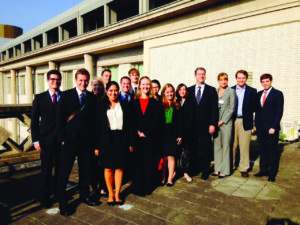Studying at The Hague

Torts? Check. Property? Got it. Contracts, CivPro, and ConLaw? All part of the required first-year curriculum at Stanford Law School and most law schools across the country. But international law? After two years at SLS, I had yet to set foot into a class addressing transnational legal issues despite spending the summer working at a firm in Washington, D.C., that sported a roster of global clients. If lawyers are increasingly asked to tackle problems that cross national borders for clients with operations in dozens of countries, shouldn’t our legal education prepare us for these types of challenges?
It was the recognition of this gap in curricular coverage that prompted SLS’s administration and faculty to launch an exciting new slate of international courses in 2014-2015. In addition to a traditional classroom component, each two-week course features a trip abroad, allowing` students to study a legal issue on the ground—be it raising venture capital funds in China or sealing a transnational merger in Brazil—and to get a firsthand view of international institutions in action.
The first of these classes, The System of International Justice: From Stanford to The Hague, kicked off in early September under the direction of professors Jenny Martinez [associate dean for curriculum, professor of law and Warren Christopher Professor in the Practice of International Law and Diplomacy] and Beth Van Schaack [visiting professor at the law school and a visiting scholar at the Center for International Security and Cooperation at Stanford University]. Twelve of us returned to Stanford two weeks before the autumn term for an intensive course in international criminal justice, spending the first week on campus before traveling to The Hague in the Netherlands for a week of meetings, visits, and observations. As is standard at SLS, my classmates brought an impressive array of experiences to the table, ranging from the self-professed “international law kids” with positions at governmental and humanitarian organizations under their belts to those, like me, who were taking their first dive into the field.
In our Stanford classroom, professors Martinez and Van Schaack led us through the history of international tribunals, the development and operation of the courts currently in session in The Hague, the types of crimes prosecuted by these courts, and the policy debates swirling around their creation. We read judicial opinions handed down by the International Criminal Tribunal for the former Yugoslavia (ICTY) and the International Criminal Court (ICC) and reviewed background material to prepare for the trials we would be observing. I’m not quite sure how they did it, but in only 15 hours of class, professors Martinez and Van Schaack had us thinking and arguing like the international criminal lawyers we would be meeting with the next week (or at least I’d like to think so!).
After an 11-hour flight to Amsterdam, a quick train ride to The Hague, and a welcome dinner atop one of the city’s tallest skyscrapers, we launched into a phenomenal week with the people actually doing the work of international criminal justice. We observed the trial of Ratko Mladi, the commander of the Bosnian Serb Army accused of genocide for his role in the massacre of thousands of Bosnian Muslims in Srebrenica, and discussed the tribunal’s work with Serge Brammertz, the chief prosecutor at the ICTY, and Judge Theodor Meron, president of the ICTY. After sitting in on the trial of Kenyan Deputy President William Ruto for charges arising from his possible role in the post-election violence in Kenya, we met with Fatou Bensouda, the ICC’s top prosecutor, and other prosecuting attorneys, defense attorneys, judges, and administrators. Our schedule also included visits to the International Court of Justice, the Special Tribunal for Lebanon, the U.S. Embassy, and NGOs including the Open Society Justice Initiative and Women’s Initiative for Gender Justice. One highlight was the reception hosted by professors Martinez and Van Schaack who between the two of them seemed to know every single person in The Hague. At the reception, we had a chance to chat with tribunal lawyers and staff members in a more casual environment. We closed our week with a fantastic Indonesian feast, said goodbye to our charming boutique hotel, and flew back to Stanford to begin the autumn quarter.
At the risk of being hyperbolic, this was one of the most incredible and rewarding academic experiences I have ever had. However, without SLS’s generous financial contribution, this trip would not have been possible for me. Stanford covered the costs of our hotel, most meals, and guided transportation throughout The Hague for the duration of our trip, asking only that I cover the cost of my flights. For my classmates holding public interest or government positions this summer, SLS took care of air travel as well. It is this kind of willingness to experiment, institutional flexibility, and commitment to the student experience that truly sets Stanford Law School apart.
My grandfather, John Barton, taught international law courses at Stanford for nearly 40 years. He passed away a few years ago, but I know he would be cheering this expansion of SLS’s vision and impact. In our increasingly interconnected global community, we need to prepare young lawyers for the careers ahead of us. Stanford Law School is doing just that, and I am thrilled I was able to be a part of it. SL
